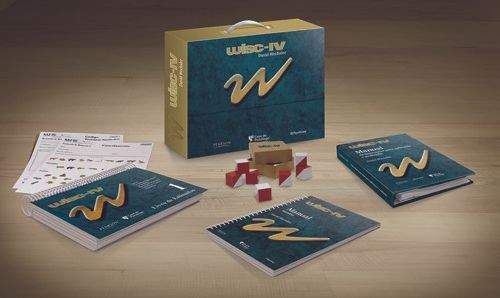The Wechsler Intelligence Scale for Children-IV (WISC-IV)

- 1654
- 412
- John Von
The Wechsler Intelligence Scale for Children is an instrument to evaluate the intelligence of children and adolescents in ages of six years, 0 months and 16 years 11 months. It includes the educational levels of primary (from six to 11), high school (12-15) and high school (first course, 16 years).
Preferably, the scale is applicable to subjects in which it agrees to identify the Dexterity level in cognitive skills or neuropsychological functioning.
Content
Toggle- Origin of the Wechsler Intelligence Scale for Children-IV (WISC-IV)
- What measures Weschler's intelligence scale?
- Quotients and subtests
- Bibliography
Origin of the Wechsler Intelligence Scale for Children-IV (WISC-IV)
According to the author María Elena Brenlla, in her article on the interpretation of the WISC-IV. Composite scores and ChC models, in 1939, Wechsler conceptualized intelligence as "the global and aggregate capacity of an individual to act for a purpose, think rationally and properly relate to the environment".
It was on the basis of this definition that designed its recognized worldwide intelligence test, for which it selected and developed measures aimed at evaluating cognitive aspects of intelligence that estimated as more relevant.
These aspects were verbal understanding, perceptual organization, abstract reasoning, quantitative reasoning, memory and processing speed. Modern measures and theories today have confirmed that these areas reflect relevant aspects of cognitive ability.
The Wechsler Intelligence Scale for Children-IV (WISC-IV) It has been widely used for screening and diagnosis of learning pathologies and neurodevelopment; learning difficulties, intellectual disability degrees, as well as neuropsychological dysfunctions.
In relation to the evaluation of attention deficit and hyperactivity disorder (ADHD), the Wechesler scale allows to evaluate the quality of attention, processing speed and perceptual reasoning rates.

What measures Weschler's intelligence scale?
The scale measures the Intelectual skills, since, it is estimated that cognitive abilities are organized following a hierarchical structure, with specific skills that are related to different cognitive areas and that represent the general intellectual skills, such as perceptual reasoning and verbal understanding.
As noted, this is also related to current theories about fluid reasoning and working memory.
The Wechsler Intelligence Scale for Children (WISC-IV) It is made up of ten main subtests and five operating subtests, with which compound scores are obtained that provide information regarding intellectual functioning in four specific cognitive areas and an intellectual quotient.
The reliability and validity of the test has been studied in various countries and continents and evidence has been found on their psychometric properties that have been satisfactory.
 The importance of grandparents for children
The importance of grandparents for children Quotients and subtests
These are divided as follows:
- Verbal understanding: where skills are expressed for the formation of verbal concepts, precision and wealth in the definition of word, relationships between concepts; Practical judgment, agility and verbal intuition, in addition to acquired knowledge, with five sub -top.
-
- Similarities (s): It measures the ability of abstraction and generalization, based on expressed concepts;
- Vocabulary (V): It measures lexical knowledge, verbal expression capacity and conceptual precision;
- Understanding (c): It measures social judgment and reasoning before the solution of everyday difficulties;
- Information (i): This test is optional and is applied to measure the ability to acquire, conserve and recover the knowledge that has been acquired;
- Riddles (AD): This test is also optional and measures the skills to integrate information and be able to generate new concepts.
- Perceptual reasoning: It measures practical skills, as well as the formation of nonverbal concepts. It is made up of four subtest:
-
- Cubes (CC): Measure the analysis, synthesis and viso-spatial organization skills;
- Concepts (CO): It measures the ability to form concepts from visual material;
- Matrices (m): It measures reasoning from visual analogies;
- Incomplete figures (FI): This test is optional and serves to measure recognition and perceptual organization capabilities.
- Work memory: Measure the information retention and storage capacity. It consists of three subtests:
-
- Digit (D): Measure working memory and immediate memory:
- Lyrics and Numbers (LN): It measures the retention capacity and combination of two types of information;
- Arithmetic (A): It is options and evaluates numerical reasoning skills.
- Information processing speed: It measures the ability to focus attention, explore, discriminate, order visual information quickly. It consists of three subtests:
-
- KEYS (CL): It measures associative speed, visual perception, motivation and learning;
- Symbols Search (BS): It measures associative speed, visual perception, resistance to repetitive tasks and viso-manual coordination;
- Animals (AN): It is optional and measures selective attention and the orderly search for information.
Information and arithmetic tests have remained optional, only to complement the interpretation of verbal comprehension and working memory indices. On this scale, it has been criticized that does not contain puzzles or comics to analyze, for example, reactions to frustration.
However, it is a test with strengths, while facilitating the analysis of the skills based on age.
Thurstone's primary mental skills
Bibliography
- Brenlla, María Elena. (2013). Interpretation of the WISC-IV: compound scores and chc models. Psychological sciences, 7(2), 183-197. Retrieved on July 15, 2021, from http: // www.Scielo.Edu.Uy/Scielo.PHP?script = sci_arttext & pid = s1688-422120130002007 & lng = es & tlng = is.
- Fenollar-Cortés, J., Navarro-Soria, i., González-Gómez, c., & Garcia-Sevilla, J. (2015). Detection of cognitive profiles using WISC-IV in children diagnosed with ADHD: Are there differences between subtypes?. Psychodidactic magazine, twenty(1), 157-176.
- Ruata, j. M., & Pérez, L. (2008). The Wechsler Intelligence Scale for Children-IV (WISC-IV) in a group of intellectual disabled. Educational psychology, 14(1).
- Wechsler, d. (2005). WISC-IV: Wechsler Intelligence Scale for Children-IV: Technical Manual(No. SIRSI) I970729227X).
- « Stress and telomeres, an insane relationship
- Obsessive Compulual Disorder Characteristics and Treatment »

